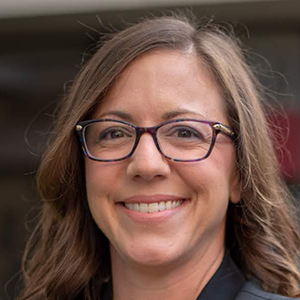What are you and your company doing to help reduce embodied carbon emissions?
Esther Obonyo
Associate professor of engineering design and architectural engineering at Penn State
Director of the Global Building Network, a partnership with the United Nations Economic Commission for Europe
My research focuses on the scaling of low carbon materials in resilient and sustainable buildings both in the United States and in other parts of the world. For example, through funding from the National Science Foundation, we have developed concepts demonstrating that engineered earthen masonry systems can be used in resilient low income housing in Florida in compliance with the design requirements for hurricane resistance. We have also demonstrated the feasibility and viability of using a similar approach in flood-prone areas along the East African Coast.
I am part of the humanitarian materials community at Penn State University. This work is being done through catalytic support from the Material Science Institute. One of our signature projects is directed at addressing the problem of carbon emissions associated with the production of fired bricks through using a of a novel Cold Sintering approach that was developed by Professor Clive Randall’s team. The Cold Sintering process occurs when inorganic powders are densified in the presence of a transient liquid phase. We have developed concepts at the laboratory scale that demonstrate that this approach can be used to turn down the heat on the production of fired bricks. Within the Pennsylvanian context, it opens new possibilities for redirecting waste from, for example, mining that cannot withstand the high temperatures required to fire bricks. We are also prototyping concepts that demonstrate the potential for deploying this approach in East Africa.
There is an active embodied carbon community at Penn State. The community, through coordination efforts led by Sustainability Institute and the Office of Physical Plant is developing concepts that are informing the University’s continued interest in modeling what is possible within Pennsylvania through our own facilities and operations. As an example, we are developing language that will be used to advise our procurement strategy.
Within the Global Building Network, we are using a strategic partnerships model to help accelerate scaled decarbonization of buildings. Our business model revolves around three pillars: 1) generating evidence for policy and practice; 2) educating future professional on high performance building systems, and 3) strengthening communities through outreach. I am very excited about network to network connections that are emerging through Carbon Leadership Forum – Philly, a chapter which was co-founded by Lisa Conway, Cecilia, and me.
I welcome conversations with any individuals or organizations that are interested in exploring potential synergies.

Esther Obonyo
What are you and your company doing to help reduce embodied carbon emissions?
Kristy Walson
Principal, TLC ENGINEERING SOLUTIONS
Growing up on a sailboat for a portion of my childhood gave me the understanding that it is possible to live in balance with nature. I thrive in spaces where passion intersects with knowledge, so it was inevitable that my engineering degree would somehow lead me to a career in sustainability. I am a vocal advocate for high performance design, smart and impactful energy optimization, and utilizing existing resources before building something new, both locally and nationally. Managing TLC’s Orlando Energy Services group has allowed me to advocate for sustainability and energy efficiency in my local community over the last 14 years. Now, I see it as my responsibility to educate the industry on Embodied Carbon so we can all make a collective effort to reduce this piece of the carbon equation.
Over the last 20 years, TLC Engineering Solutions has been an advocate and educator for optimizing energy use in the built environment. We incorporate high performance design strategies and energy modeling on our projects, and we’ve participated on multiple standards committees related to reducing Operational Carbon. Additionally, we have presented hundreds of times on the benefits of early energy modeling and utilizing modeling as a tool throughout design.
But, there was a piece missing from our message: Embodied Carbon. We have evolved our project approach to consider the impact of Whole Life Carbon (both operational and embodied carbon).
Building on the work of organizations and initiatives like the Carbon Leadership Forum, Architecture 2030, and SEI 2050, TLC’s effort has been to educate, by both advocating for whole life carbon reduction on design projects and presenting to the industry any chance we get. We highlight two key points: 1) Structural and envelope embodied carbon optimization can have a dramatic impact on the whole life carbon total of a building, and 2) Right-sizing and mindful placement of larger mechanical equipment can allow for smaller structural systems.
In a way, starting with Operational Carbon has given our industry a framework for starting with a baseline and optimizing almost anything. Using the processes already well-established for reducing operational carbon, we can set whole-life carbon goals early on and use these as a roadmap for the design team as the project progresses.

Kristy Walson
What are you and your company doing to help reduce embodied carbon emissions?
Nakita Reed
Associate at Quinn Evans, Co-Chair Zero Net Carbon Collaboration
At a young age I was perplexed by seeing homeless people and dilapidated vacant buildings in the same area. Issues of homelessness and vacancy are complex but ultimately people need buildings and buildings need people. Reusing the existing building stock via deep green retrofits is imperative to provide more affordable housing and bolster the embodied carbon work being done around the world. I’m grateful to be part of the Zero Net Carbon Collaboration (ZNCC) to continue to include existing and heritage buildings in the climate action conversation.
To help reduce embodied carbon emissions I’m working to raise awareness about the need to include existing and historic buildings in the climate action conversation. Both as an Associate at Quinn Evans and as a co-chair of the Zero Net Carbon Collaboration, exploring the intersections of historic buildings and sustainability is a focus of my work.
At Quinn Evans, the majority of our projects – historic and new construction – are tracking various sustainability performance metrics. Our project teams are continuously looking for ways to improve performance and understand the sustainable story in each project.
The mission of the Zero Net Carbon Collaboration for Existing and Historic Buildings (ZNCC) is to rapidly accelerate the achievement of Zero Net Carbon (ZNC) for the existing and historic built environment, accounting for both embodied and operational emissions. We monitor technological development and coordinate best practices for the ZNC rehabilitation of existing buildings to facilitate the responsible reuse of built resources.

Nakita Reed
What are you and your company doing to help reduce embodied carbon emissions?
Reshma Singh
Executive Director of IMPEL+ at Berkeley Lab an early-stage incubator and accelerator for building-energy technologies
Coming to the United States in 1997 was an electric shock. I was just fascinated by the sheer electricity waste as I rode the bus home late nights from university, learning about sustainable architecture, but seeing all the lights on in every glass building in Boston. That year I received Harvard’s Community Service Fellowship to help convert a 1920s Art Deco Cambridge home into net zero apartments using a plethora of methods ranging from a geothermal energy-based radiant system to melt driveway snow to kitchen water irrigation for the community garden.
Fast forward a few years, I dove into building science research at Berkeley Lab to tackle such issues as part of a five-year US-India bilateral program on building energy efficiency, CBERD. That journey led to two cleantech devices and a book “Building Innovation” through which I was fortunate to meet Andrew and Kate at the Carbon Smart Building Day in San Francisco. CLF has re-awakened my passion for low carbon, biogenic, circular architecture, a throwback to my decades-ago work in India with a migrant potters community to create rapid homes made of wheel-thrown artifacts. This integration of embodied and operational carbon has come alive in Berkeley Lab’s white paper with Infosys and the Indian Institute of Science we released this Thanksgiving: “Transforming India’s Built Environment: A 2050 Vision for Net Zero, Resilience and Wellness”.
In my current work with the U.S. Department of Energy building tech-to-market program IMPEL+ we have recruited and fostered 100+ building innovators, empowered them with coaching and mentoring, and enabled access to powerful public-private tech-to-market pipelines. Our “Decarbonize” track focuses on innovations to radically reduce embodied and operational carbon, and promote circularity towards a zero carbon built environment; “Digitalize” track on digital design, supply chains, construction, and building-to-grid operations; and “Democratize” track on innovations that provide equitable access to wellness in a resilient, living environment.

Reshma Singh







